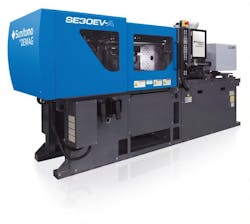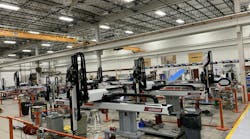By Karen Hanna
Sumitomo is expanding its SEEV-A family of all-electric machines with a wee press that can handle shot sizes ranging from 0.5 ounce to 1.3 ounces.
The company’s new 34-ton SE30EV-A boasts a next-generation, fast-response controller for its servomotors, the ISC II, which stands for Intelligent Servo Control. The press replaces the SE30DUZ, which did not have the controller, and becomes the smallest in the SEEV-A line, which ranges up to 562 tons of clamping force. Built for clean-room compliance, it has injection rates as fast as 600mm per second. It boasts precise, stable, high-quality production, and can mold parts with tolerances measured in microns.
Its precision is key.
In an interview about micromolding, Tony Marchelletta, the Midwest regional sales manager for Sumitomo (SHI) Demag, ticked off some of the challenges of the process.
“Materials can be very challenging. Medical implantables, for example, tend to be very temperature- and shear-sensitive,” he said. Because of that, “residence time must be minimized and shear kept to a minimum.”
With the growing use of exotic, expensive materials, especially for the health-care industry, micromolders are increasingly challenged to take a stingy approach to resin consumption, rather than just increase runner size, as they have in the past. “Consequently,” Marchelletta said, “the machine is being challenged to control fractional-gram shots as runners are reduced or eliminated.”
Using the company’s Flow Front Control (FFC) system, the SE30EV-A fills each cavity perfectly without overpacking or creating flash. The FFC system takes advantage of the energy in the flow front of the resin to fill cavities evenly with minimal injection pressure. It uses Sumitomo-built, third-generation, direct-drive servomotors for injection and plasticizing. Along with the ISC II, machine components ensure the extremely fast-response screw control and process stability that micromolding requires.
Additionally, the machine offers a plethora of advantages, according to Marchelletta, including a new linear guidance system for improved mold linearity and parallelism; a center press platen design that allows even distribution of pressure across the mold surface; and a gas-release mode that ensures proper venting.
High-pressure, high-response options also are available. Sumitomo’s Spiral Logic (SL) screw packages designed for precise resin dosing — even pellet by pellet — are among other options.
“Process stability is of paramount importance for micromolding, and our combination of advanced, direct-drive, all-electric machine technology, the Z-[Molding] and the SL screw assembly are equipped to meet even the most demanding micromolding applications,” Marchelletta said.
Z-Molding brings together three Sumitomo technology packages: the FFC system; the company’s Minimum Clamping Molding system, which reduces clamping force requirements and ensures optimized venting of gases and flash-free molding; and the Simple Process Setting system, which provides fast, guided setup, ease of use and machine optimization.
Karen Hanna, associate editor
Contact:
Sumitomo (SHI) Demag, Strongsville, Ohio, 440-876-8960, www.sumitomo-shi-demag.us
Vital Statistics
| Clamping force | 34 tons |
| Distance between tie bars | 12.2 inches by 11.4 inches |
| Overall size of platens | 17.3 inches by 16.5 inches |
| Maximum open daylight | 20.1 inches (22.8 inches, optional) |
| Minimum to maximum mold space | 5.1 inches to 11.8 inches (up to 13.8 inches, optional) |
| Screw diameter | 18mm to 25mm (depending on plasticizing unit) |





